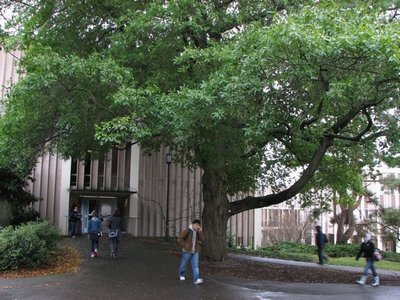February 7, 2008
Campus trees: Extraordinary, exemplary or merely significant?
What makes a tree worth saving? That’s a question that is frequently debated on campus when new construction or remodeling forces the clearing of particular patches of land. Up until now, according to University Landscape Architect Kristine Kenney, there hasn’t been an objective way to judge any given tree.
“Someone may be personally attached to a particular tree because it sits outside her office window, providing seasonal interest and attracting wildlife,” Kenney said. “But that isn’t a valid reason to save the tree.”
Still, she says, some trees do have inherent significance. Take the water oak at the southwest entrance to Balmer Hall, for example. It’s one of only two such trees on campus, it’s in excellent condition, it’s aesthetically pleasing and it’s included on the Brockman Tree Tour, an educational tour of the campus’ trees. Yet the water oak will be removed to make way for a new building for the business school.
It was that sad circumstance that led former campus arborist Deb Brown to start thinking about objective ways to evaluate the trees on campus. She took her concerns to the University Landscape Advisory Committee, and its members agreed that an evaluation system was needed. So Brown and Kenney collaborated to produce a systematic procedure for doing just that.
“We started by looking at the Heritage Tree program at the University of North Carolina,” Kenney said. “But they have only one level of designation and it wasn’t clear just what it meant. We wanted to go further than that.”
Under the system she and Brown developed, a tree could attain one of three levels of designation — significant, exemplary or extraordinary — each of which would confer a level of protection. But before a tree could even be considered for these designations, it would have to be judged to be in good condition.
For that, Kenney and Brown turned to a standard developed by the Council for Tree and Landscape Appraisers. Under that standard, a tree will receive maximum points if its crown development is characteristic of the species and well balanced, its trunk is sound and solid, its major branch structure has no defects, its twig growth rate is typical for its species and age, its foliage is a normal size and color for the species, it is free of insects and disease and there are no apparent root problems.
“A tree would have to have a 70 percent condition assessment rating before it could be considered for one of the special designations,” Kenney said.
A tree that passed the condition assessment would then be judged on four other criteria:
- Rarity: The species is rare (three or fewer similar species on campus) and significantly contributes to the distinct plant life of the campus.
- Specimen: The tree exemplifies the ideal characteristics of native or exotic species due to size, habit (the ultimate form or outline of the plant — for example, a vine, small tree, shrub, etc.), form or condition.
- Aesthetic: Contributes either as an individual tree or grouping of trees that help define the structure of a landscape or frame a view.
- Cultural/Educational: Serves as a symbolic representative relative to a historic event or time period, or serves educational importance as part of a teaching collection.
A tree that meets at least three of the four criteria would be classified as “extraordinary”; a tree that meets two would be “exemplary”; a tree that meets one would be “significant.”
And what would these designations mean in the real world? “Extraordinary trees are trees that we really should try to preserve,” Kenney said. “They should not be removed unless absolutely necessary. The design team would have to show through their plans why they cannot keep the tree. It would be their burden to prove that.”
As an exercise, Kenney and Lou Stubecki, the former arborist for the UW Botanical Gardens, put the water oak at Balmer through the evaluation system and it came through with an “extraordinary” rating. But there was no evaluation system in place when plans for the new building were developed.
Of course, even if there had been, it might have been impossible to avoid eliminating the tree. What then? “What we’re proposing is that the tree be appraised using the Council for Tree and Landscape Appraisers Trunk Formula method,” Kenney said. “That produces a dollar value for the tree. And that amount would be taken from the construction project budget and placed in a tree replacement fund.”
The fund could then be used to plant trees wherever they were needed, not necessarily in the area of the construction project that contributed the money.
The new system has never been used, but Kenney says it will soon be tested. There are three new projects coming up — the renovation of Lewis and Denny Halls and the construction of a new Molecular Engineering Building — and for each, the University Landscape Advisory Committee has requested that the project team hire an arborist to do an assessment of the trees. A condition rating has already been obtained.
“If the system works as we hope it will, we’ll implement this as standard policy for future projects,” Kenney said. “We know we can’t save every tree. But this at least helps us make people aware of the trees that truly do have significance.”



